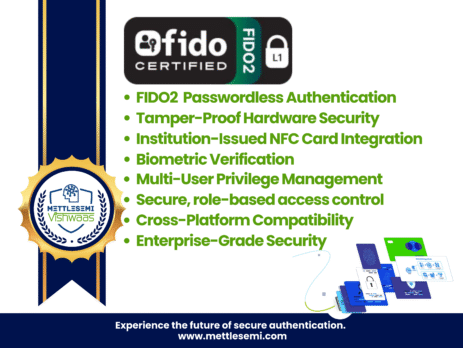Are you still using passwords?
Let’s be honest, passwords are outdated.
They’re hard to remember, easy to steal, and vulnerable to phishing, data leaks, and replay attacks.
They’re a hassle to manage and a nightmare when compromised.
So, is there a smarter and more secure way to log into your important accounts?
Yes! That’s where FIDO comes in.
FIDO stands for Fast IDentity Online.
It’s an open standard developed by the FIDO Alliance—a global consortium of the world’s leading technology companies—designed to help us move beyond passwords.
Instead of remembering long, complex strings, FIDO lets you authenticate using passkeys—a more secure, easier-to-use alternative.
Today, more than 250 companies worldwide rely on FIDO standards.
And it’s only getting better. The latest version, FIDO2, supports hardware-based authentication and web browser integration, opening up a world of new possibilities for secure access—across devices, platforms, and services.
So how does FIDO deliver on passwordless authentication?
Meet Passkeys—the next step in authentication.
They replace passwords with a pair of cryptographic keys.
- One key stays securely on your device
- The other resides with the service you’re logging into
Only your device can unlock these keys—and only after you authenticate.
With the Mettlesemi Vishwaas Authenticator, this happens through Advanced Multifactor Authentication:
- An NFC card — something you have
- Biometrics — something you are
- A PIN — something you know
Let’s see how Passkeys work.
Registration:
When you first create an account on a website, your device receives a Make Credential request from that service.
It then generates a cryptographic key pair:
- A public key, which is shared with the service
- A private key, which remains safely stored on your device
The service stores the public key and links it to your user account—replacing the need for a traditional username and password combination.
Authentication:
Now, when you log in again, the web server says,
“Hey, I remember you—you registered earlier. I have your public key on file.”
(Remember: public keys are safe to share—only private keys must remain secret.)
The server sends you a challenge, which only your private key—stored on your device—can decrypt.
You then authenticate using your credentials—like your NFC card and biometrics.
Your device signs the challenge response with the private key and sends it back.
The server checks the response. If it matches, you’re authenticated and logged in—without ever entering a password.
Why is this so secure?
Because:
- Passkeys are phishing-resistant
- They can’t be reused
- And what’s encrypted with one key can only be decrypted by the other
This makes your authentication virtually tamper-proof.
Who’s using this today?
Tech giants like Google, Apple, and Microsoft already support passkeys.
They’re leading the shift towards a passwordless future.
So, why wait?
Say goodbye to passwords.
Say hello to passkeys.
Ready to go passwordless?
Explore the Mettlesemi Vishwaas Cross-Platform FIDO2 Certified Authenticators—
your gateway to secure, seamless authentication for today and tomorrow.


